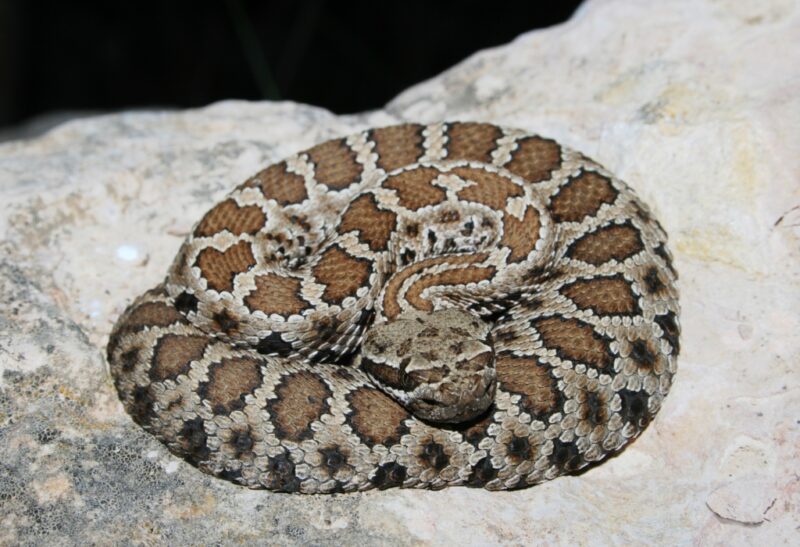Rattlesnakes are pit vipers characterized by the small pits located on each side of their heads and a rattle made out of loose-fitting, interconnected scales that form on their tails. They are present in nearly all states, with an abundance in Arizona.
Rattlesnakes in Arizona includes:
- Twin-Spotted Rattlesnake
- Banded Rock Rattlesnake
- Western Diamondback Rattlesnake
- Southwestern Speckled Rattlesnake
- Ridge-Nosed Rattlesnake
- Prairie Rattlesnake
- Northern Blacktail Rattlesnake
- Tiger Rattlesnake
- Great Basin Rattlesnake
- Arizona Black Rattlesnake
- Grand Canyon Rattlesnake
- Sidewinder Rattlesnake
- Mohave Rattlesnake
- Desert Massasauga Rattlesnake
This article discusses everything you need to know about rattlesnakes found in Arizona, their physical attributes, distinctive characteristics, place of origin and habitat, and other interesting information. Read further for more!
Table of Contents
How Common Are Rattlesnake Bites in Arizona?
There are about 200 rattlesnake bites reported to poison centers in the state annually. However, not all those who are bitten by rattlesnakes seek professional care, so experts estimate that there are about 250 to 350 bites a year.
What Is the Most Dangerous Rattlesnake in Arizona?
The Mohave Rattlesnake has the most toxic venom out of all the rattlesnake species in the world. Its venom contains hemotoxins that affect the blood and organs and cause excessive bleeding, as well as neurotoxins that affect the nervous system and can lead to paralysis, seizures, and, in worst-case scenarios, death when left untreated.
However, the Western Diamond-backed Rattlesnake has caused the most bites and deaths in the state compared to the Mohave since the latter is generally a timid species.
Where Are the Most Rattlesnakes in Arizona?
Most rattlesnakes in Arizona live in desert areas and mountainous regions. However, according to a snake removal expert, most of the snake sighting reports come from the Valley fringes.
14 Rattlesnakes in Arizona
Twin-Spotted Rattlesnake

Twin-spotted Rattlesnakes fascinate scientists from an evolutionary and ecological perspective since their morphologies resemble that of the early rattlesnakes.
Although they are native to the state, they are rare as they are elusive species. However, when foraging for food, they are considered ambush predators. Their rattles are believed to sound like insects.
- Scientific Name: Crotalus pricei
- Appearance: Small, moderately stout body with a triangular head, rough scales, and a short tail
- Color: Ranges in color from brown to gray, sometimes with a purplish hue, and are distinguished by the two rows of dark and paired spots on its dorsal surface for which they are named.
- Habitat: Rocky slopes, canyon bottoms, ridges, evergreen woodlands, and forests found on mountain ranges
- Lifespan: Up to 16 years (captivity)
- Length: 38.2 to 60 centimeters
- Diet: Lizards, mice, woodrats, small birds and their nestlings, and even other snakes.
- Place of Origin: Southwestern United States and Northern Mexico
- Venomous: It has a Type I venom which is characterized by a high level of metalloproteinase or enzymes that can induce various dangerous health concerns such as hemorrhages, but low in toxicity. This means that envenomations don’t usually cause death but can still bring pain and discomfort.
Banded Rock Rattlesnake
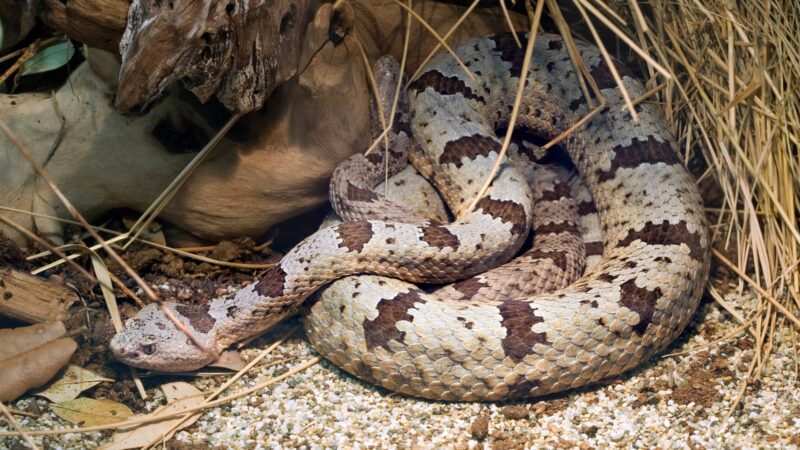
Banded Rock Rattlesnakes are rarely observed in the state due to their elusive nature, unsuspecting coloration, small size, and agility. Interestingly, it shares the same range as the similarly-looking Gray-banded Kingsnake. In fact, the kingsnake’s appearance may be an adaptation as a form of mimicry to protect against predators.
- Scientific Name: Crotalus lepidus klauberi
- Appearance: Small snake with a slender body, distinctively wide and triangular head, and a proportionately small rattle.
- Color: Light gray overall color with bands that are grayish black with serrated, saw-like edges found along the length of its body. Patterns can vary among sex and geographic location. Some can have heavy spotting or a distinctive facial stripe across the face.
- Habitat: Arid and semi-arid habitats such as tropical deciduous forests, grasslands, rocky flats, mountains, and outcrops found at elevations of up to 2,930 meters
- Lifespan: Up to 33.6 years (captivity)
- Length: 60 to 80 centimeters
- Diet: Small rodents, lizards, birds, small mammals, invertebrates, and other snakes.
- Place of Origin: Southern United States and Mexico
- Venomous: Despite being considered moderately venomous, a bite from an adult snake can result in severe envenomation if not treated immediately. It has hemotoxic properties, but some snakes also have neurotoxic properties.
Western Diamondback Rattlesnake
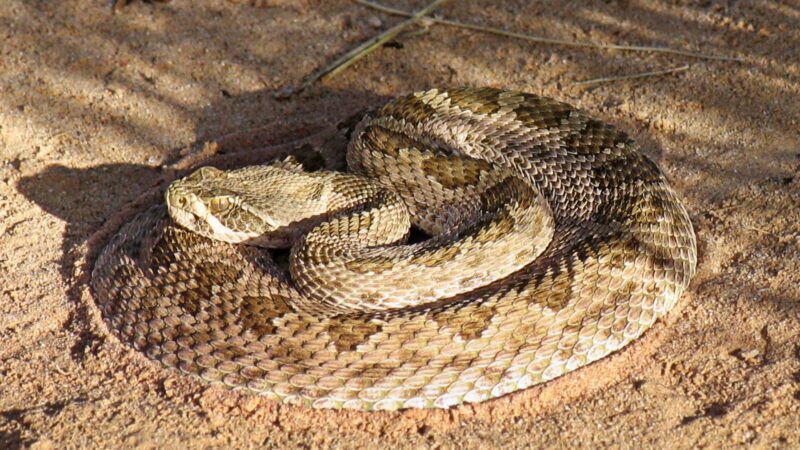
This species is the longest snake and also one of the most often encountered by residents in Arizona. They are easily excitable, highly aggressive, and defensive. When threatened, they assume a posture by slightly flattening their body, rolling it over to create a spiral shape, lifting their forebody from the ground, and raising their tail with the rattle rattling.
- Scientific Name: Crotalus atrox
- Appearance: Plump-bodied viper with a broad, triangular head, short tail, and diamond-patterned scales
- Color: Ground color can be pale blue, yellowish gray, or pinkish. The diamond shape pattern on its body is dark in color and white-ringed. Its tail is white and jet black-ringed while its head markings have a pale band from its upper labials up to its nostril, as well as a similar band but much narrower located behind the eye.
- Habitat: Any terrain that is dry, rocky, and covered with shrubs, preferably with mouse holes or rocks
- Lifespan: Up to 20 years (captivity)
- Length: 76.2 centimeters to 1.83 meters
- Diet: Rabbits, mice, rats, gophers, lizards, ground-dwelling birds, and other small animals
- Place of Origin: Southwestern United States and Mexico
- Venomous: Its venom is hemotoxic to its prey. It’s also known to bite hundreds of people annually, making them responsible for most of the snake bite fatalities in the United States, along with the Eastern Diamondback Rattlesnake.
Southwestern Speckled Rattlesnake
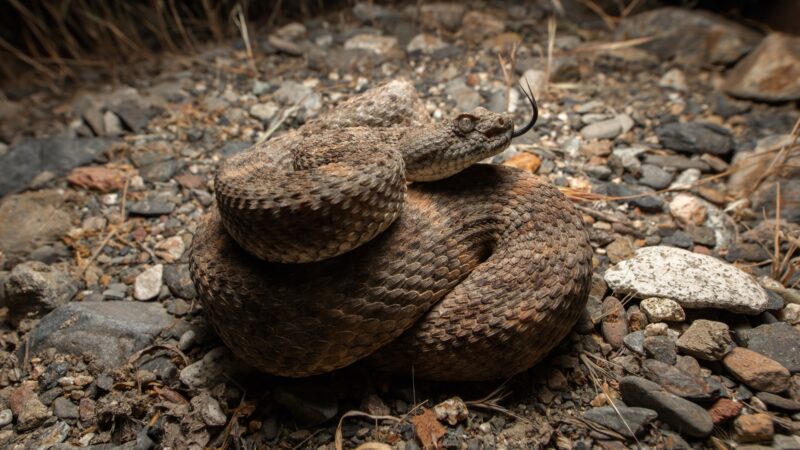
This rattlesnake species is often recognized by its faded colorations, which usually match the surroundings they are in. Bites made by the Southwestern Speckled Rattlesnake are usually described as a sharp pain felt within 45 seconds, disappears, but gradually intensifies as time goes by, and usually, there is always a considerable amount of progressive swelling.
- Scientific Name: Crotalus pyrrhus
- Appearance: Medium-sized snake with a heavy body, narrow neck, a triangular head, and a ringed tail.
- Color: Depends on their environment, particularly the color of the soil and rocks. It can be brown, gray, pink, yellow, nearly white, or a mix of black and white colors. If it has patterns, it is usually banded, blotched, or rhombic along its length. Its face usually doesn’t have any markings.
- Habitat: Rocky terrains such as canyons, hillsides, talus slopes, and ledges. They can also be found in cactus or chaparral terrains.
- Lifespan: Up to 22 years (captivity)
- Length: 58 to 120 centimeters
- Diet: Small mammals such as rabbits and ground squirrels, birds such as goldfinches, and lizards
- Place of Origin: Southwestern United States and Northwestern Mexico
- Venomous: Envenomations are not usually life-threatening but may still involve pain and discomfort. However, a patient from Phoenix Mountains was bitten by this snake species. He experienced tissue damage on his middle finger and had to amputate the distal part of it.
Ridge-Nosed Rattlesnake

In 1986, the Ridge-nosed Rattlesnake has deemed the official state reptile of Arizona. It was the last species of rattlesnake to be determined by herpetologists or reptile and amphibian specialists, having first discovered in 1905. They live particularly in the Santa Rita, Huachuca, and Patagonia mountains of the state.
- Scientific Name: Crotalus willardi
- Appearance: Moderately robust body with a long, triangular head, sharp and upward-turning edge along its upper snout giving it its name, narrow neck, short tail, and ridged scales along the length of its body.
- Color: Coloration ranges from yellowish gray to an orange-brown or reddish brown color, with black-edged, narrow white bands. The sides of the face are particularly marked with these sharply contrasting white bands.
- Habitat: Mountain ranges, woodlands, and forests found in elevations of 4,000 to 9,000 feet.
- Lifespan: Up to 21.3 years (captivity)
- Length: 45 to 90 centimeters
- Diet: Rodents, lizards, centipedes, small mammals, and passerine birds
- Place of Origin: Southwestern United States and Mexico
- Venomous: It has a hemotoxic venom but is considered not life-threatening as there are currently no documented deaths caused by this species. This is attributed to its small size and low venom yields. However, pain and discomfort through its bite can still be felt.
Prairie Rattlesnake

Prairie rattlesnakes are only aggressive when they feel threatened. They usually hunt for prey during the colder temperatures of summer as they are more resilient to the cold compared to other snakes, particularly those living in South Dakota, which are known to survive through extreme winter conditions.
- Scientific Name: Crotalus viridis
- Appearance: Flat and triangular head, narrow neck, two or more nasal scales compared to other snakes, and big fangs that are referred to as solenoglyphous teeth.
- Color: Black to light brown hue on their dorsal surface and a yellow stripe found on their head. Its ventral side usually blends with the ground as a means of camouflage and is typically gray, tan, or yellowish in color. It also has blotches or patterned stripes on its body; the color depends on its surroundings.
- Habitat: Rugged or rocky environments that are 100 to 2,700 feet in elevation as well as open fields that are abundant with prey, forests, chaparrals, and dry grasslands.
- Lifespan: Up to 20 years (wild), up to 24 years (captivity)
- Length: 25 to 165 centimeters
- Diet: Rodents such as deer mice, chipmunks, voles, smooth-toothed pocket gophers, red squirrels, shrews, and woodrats. They also eat birds and eggs as well as other reptiles.
- Place of Origin: Southwestern Canada, Western United States, and Northern Mexico
- Venomous: It has a highly potent venom with both cytotoxic and hemotoxic properties. Envenomations in dogs are known to have a high morbidity rate but a low mortality rate.
Northern Blacktail Rattlesnake

This species is characterized by its dark blotches along the length of its body which serves as a cryptic means of protection against predators, which includes the Western Diamondback Rattlesnake. They are occasional climbers as they have been observed “sunbathing” 2.5 meters above the ground.
- Scientific Name: Crotalus molossus
- Appearance: Stout-bodied snake with a large and triangular head, narrow neck, and short tail. It has bulging muscles on its head and varying patterns on its back that can be blotched, crossbanded, or diamond-shaped.
- Color: Ranges in coloration from black, olive-gray, reddish brown, greenish yellow, to yellow. Its tail is black regardless of subspecies and geographic location. It also has a distinctive dark band between its eyes and a dark stripe that runs diagonally from its eye to the corner of its mouth. Its body has a series of patterns that are dark in color.
- Habitat: Grasslands, mountainous areas, deserts, and forests found at high altitudes, preferably pine-oak and boreal.
- Lifespan: Up to 18 years (captivity), up to 20 years (wild)
- Length: 71.1 to 125 centimeters
- Diet: Primarily rodents, small lizards, birds, and other small mammals such as rats, rabbits, and squirrels.
- Place of Origin: Southwestern United States and Mexico
- Venomous: It primarily has hemotoxic properties but is only considered two-thirds as toxic compared to the venom of the Western Diamond-backed Rattlesnake and, hence, is not fatal to humans. However, it can still cause swelling and pain on the bitten extremity.
Tiger Rattlesnake
The Tiger Rattlesnake can certainly pack quite a punch, or bite when it comes to venom toxicity. Despite its small size, it has a complex genotype that produces simple traits, which is why even if they have lower venom yields, they are still incredibly venomous.
- Scientific Name: Crotalus tigris
- Appearance: Small-sized snake with a distinctive spade-shaped head, large rattle, crossbands across the length of its body, and keeled scales that are arranged in rows.
- Color: Can be pink, orange, yellowish brown, lavender, or gray in coloration. They have a series of up to 52 brown, gray, or olive bands across their dorsum, with up to 10 posterior rings, and a distinguishable dark cheap strip.
- Habitat: Rocky canyons, foothills, ravines found in mesquite grasslands or deserts, thorny scrub, and outcroppings.
- Lifespan: Up to 25 years (captivity)
- Length: 46 to 91 centimeters
- Diet: Primarily feeds on lizards and small mammals, including kangaroo rats, woodrats, pocket mice, and deer mice.
- Place of Origin: Southwestern United States and Northwestern Mexico
- Venomous: Its venom is considered the most toxic of all rattlesnakes found in neotropical habitats since it contains both myotoxin and neurotoxin.
Great Basin Rattlesnake
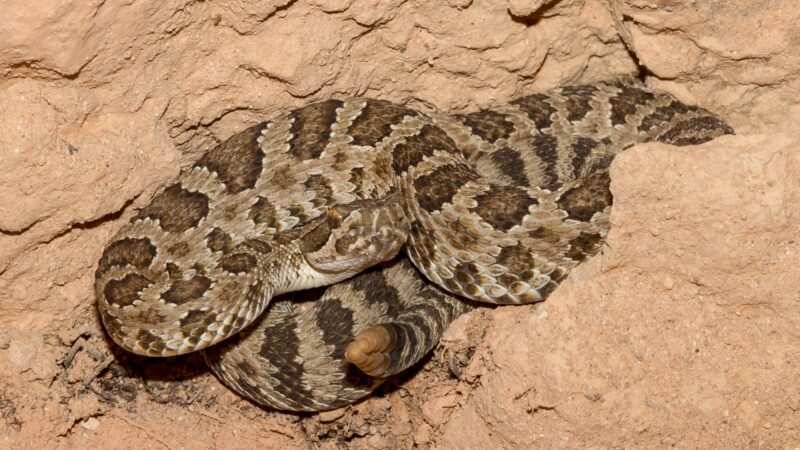
Named after its geographical location, the Great Basin rattlesnake is an elusive subspecies of the Western rattlesnake due to its nature and their ability to blend well with its environment thanks to its cryptic coloration.
- Scientific Name: Crotalus oreganus lutosus
- Appearance: Heavy-bodied snake with a large and triangular head, narrow neck, and scales that are large, keeled, and arranged in rows.
- Color: Gray, light brown, buff, or yellow coloration with a row of brown, black, or silver-colored blotches along the length of its back. These blotches also run down to its tail where they are more prominent.
- Habitat: Talus slopes, prairie dog towns, rocky outcrops, and stony canyons
- Lifespan: Up to 19.5 years (captivity)
- Length: 40.6 to 162.6 centimeters
- Diet: Adults usually feed on rodents such as chipmunks, woodrats, and mice while juveniles consume lizards and small mice.
- Place of Origin: Great Basin region
- Venomous: Its venom has hemotoxic properties. Other information regarding its venom is currently unknown as there have not been many snake bite reports for this species.
Arizona Black Rattlesnake
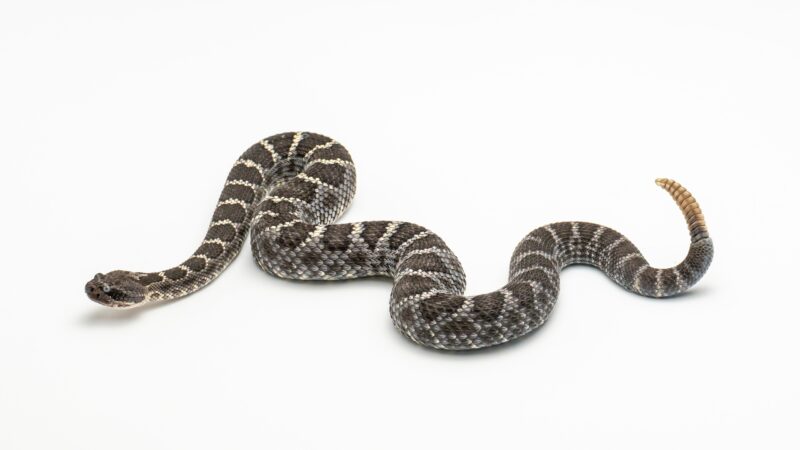
Arizona Black rattlesnakes are named after their geographical location and dark coloration although lighter-colored morphs exist. This species changes colors due to the quality or number of chromatophores, or color-producing cells, they have in their body. This is a similar mechanism to how chameleons and other lizard species can change color. It is currently unknown why this phenomenon exists in this species.
- Scientific Name: Crotalus cerberus
- Appearance: Medium-sized snake with a triangular head and hexagonal blotches on its scales.
- Color: Darkly pigmented body, usually a black color but can also be brown, gray, or have a reddish hue. Its blotches are white with yellow edges and become crossbands while it is near the tails. Some can have a uniformly dark color and lack any pattern. For lighter-colored snakes, they have a prominent stripe running across its eye.
- Habitat: Chaparral habitats, pine-oak woodlands, and blocky volcanic outcrops
- Lifespan: 15 to 20 years (captivity)
- Length: 61 to 122 centimeters
- Diet: Rats, mice, squirrels, birds, and lizards
- Place of Origin: Arizona and Western New Mexico
- Venomous: Its venom is considered to be moderately toxic but still requires immediate medical care regardless.
Grand Canyon Rattlesnake
Confined within the walls of the Grand Canyon, this species can escape predators and detections from humans due to its cryptic coloration and elusive nature. The Grand Canyon rattlesnake is known to move an average of 26 meters a day and, compared to other subspecies of the Western Rattlesnakes, they exhibit low directionality of movements.
- Scientific Name: Crotalus oreganus abyssus
- Appearance: Medium to large-sized snake with a narrow neck and a broad, triangular-shaped head
- Color: Usually pink in coloration with blotches that can also be pink, reddish, light tan, yellow, green, or gray in color. These blotches become crossbands as it approaches the tail. Some may also have markings on the face.
- Habitat: Grasslands, scrublands, rolling hills, pine forests, and talus and cliff slopes that are adjacent to rivers, streams, and springs
- Lifespan: Up to 20 years (captivity)
- Length: 41 to 137 centimeters
- Diet: Primarily feeds on lizards, mice, squirrels, and birds
- Place of Origin: Arizona and Utah
- Venomous: It is venomous. There is not much known about the properties of this species’ venom.
Sidewinder Rattlesnake
Sidewinder rattlesnakes are among the most encountered rattlesnake species in the state. They are known for their distinctive locomotion method which is sidewinding their way through sand or other alternate substrates. With the help of their tactile senses to allow them to feel their body parts touching the ground, they also move in lateral undulations and a rectilinear motion.
- Scientific Name: Crotalus cerastes
- Appearance: Small snake with a broad and triangular head, thin neck, spike-studded bellies, and distinctive horn-like scales on top of its head
- Color: Color pattern ranges from ash gray, yellowish-brown, buff, pink, to cream. They can have up to 47 blotches on their dorsal surface that are somewhat rhombic or elliptical in shape.
- Habitat: Desert landscapes, including sand dunes, sandy washes, and open terrains, preferably away from mountainous terrains.
- Lifespan: Up to 13 years (wild), up to 20 years (captivity)
- Length: 44.6 to 61.5 centimeters
- Diet: Mainly desert reptiles such as snakes (western ground snakes and glossy snakes) and lizards (western zebra-tailed lizards and Colorado desert fringe-toed lizards), but they also consume mammals such as gophers and mice as well as birds such as sparrows and wrens.
- Place of Origin: Southwestern United States
- Venomous: Its venom is known to have hemorrhagic effects
Mohave Rattlesnake
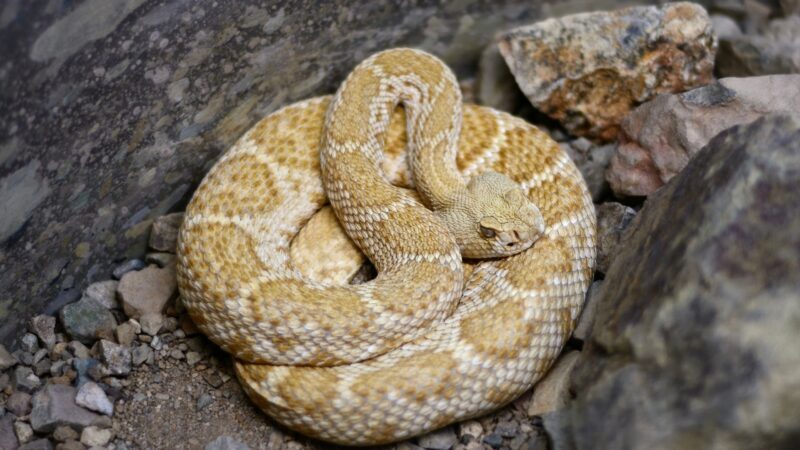
Also known as the Mojave Green due to its distinctive coloration, this rattlesnake is extremely dangerous due to its highly potent venom. They serve as a fascinating model species for evolutionary studies and population genetics as they continue to challenge science’s predictions according to researchers.
- Scientific Name: Crotalus scutulatus
- Appearance: Large and sturdy body with a triangular head, narrow neck, enlarged scales on the snout, and a hexagonal or diamond-shaped pattern
- Color: Greenish tinge on its body, black and white or gray-ringed tails with wide white spaces, and diamond or hexagonal pattern sharply outlined with white
- Habitat: Barren desert, foothills, open juniper woodland, scrubland, mesquite flatlands, and grassland, preferably away from dense vegetation and broken rocky terrain
- Lifespan: Up to 23 years (captivity)
- Length: 61 to 130 centimeters
- Diet: Squirrels, mice, rats (with a preference for kangaroo rats), rabbits, birds, and other reptiles such as toads and lizards.
- Place of Origin: Southwestern United States and Central Mexico
- Venomous: This species is known to have one of the most potent venoms in North America since it has both neurotoxic and/or hemorrhagic effects, but these effects can vary depending on their geographic range.
Desert Massasauga Rattlesnake
The Desert Massasauga Rattlesnake is an extremely cryptic and timid snake that will likely flee to a safe, hidden location if necessary. It hunts by hiding under woody debris, vegetation, and other covers or by simply remaining motionless and relying on its unseeming coloration. In Arizona, it is the rarest species of rattlesnake, with populations that are declining.
- Scientific Name: Sistrurus tergeminus edwardsii
- Appearance: Thick and stout body with a triangular-shaped head and a keratinized rattle found at the end of its tail.
- Color: Typically gray to light brown coloration with black-outlined brown semicircular blotches on its dorsal surface. Its ventral surface is unmarked and often light tan to white in color. The tail is banded with alternating grays and brown or dark grays. It has a keratinized rattle at the end of its tail.
- Habitat: Grasslands, shortgrass prairies, sagebrush, and low-lying wet areas
- Lifespan: Up to 20 years (captivity)
- Length: 58.8 to 66 centimeters
- Diet: Small rodents such as voles, shrews, and mice. They occasionally feed on frogs and other snakes.
- Place Of Origin: Midwestern North America
- Venomous: Its venom is toxic but its yields are low, which means human envenomations are unlikely to be life-threatening but can still be potentially serious.
What Time of Day Are Rattlesnakes Most Active in Arizona?
Rattlesnakes in Arizona are usually diurnal (active during the morning) and crepuscular (active from dusk until the evening) during the spring and fall seasons. During the summer season, especially on hot days, they tend to be nocturnal.
What to Do if You Come Upon a Rattlesnake?
Remain calm and remove any pieces of jewelry, accessories, or restrictive clothing you have around the affected area. Keep the bitten area below heart level, avoid applying ice at all costs, and cease or at least decrease any physical activity as much as possible. Immediately rush yourself to a medical facility or call a medical professional right away and let them treat the bitten area.
How Long Do You Have After Being Bitten by a Rattlesnake?
It depends on the species and amount of venom injected since not all bites are the same. Generally, severe or life-threatening symptoms and side effects can occur within minutes, or in some cases hours, after being bitten. This is why medical attention must be given immediately to avoid serious injury or death.
Where Do Rattlesnakes Usually Bite?
The majority of the reported snakebites in the United States usually occur on the ankles, feet, and hands.
List of Sources
Ingmarsson, L. (2002). Crotalus atrox. Animal Diversity Web.
Russell, H. (2022). Crotalus viridis. Animal Diversity Web.
Desai, M. (2004). Crotalus molossus. Animal Diversity Web.
Wesolowski, V. (2011). Crotalus tigris. Animal Diversity Web.
Faulkner, C. (2021). Crotalus cerastes. Animal Diversity Web.
